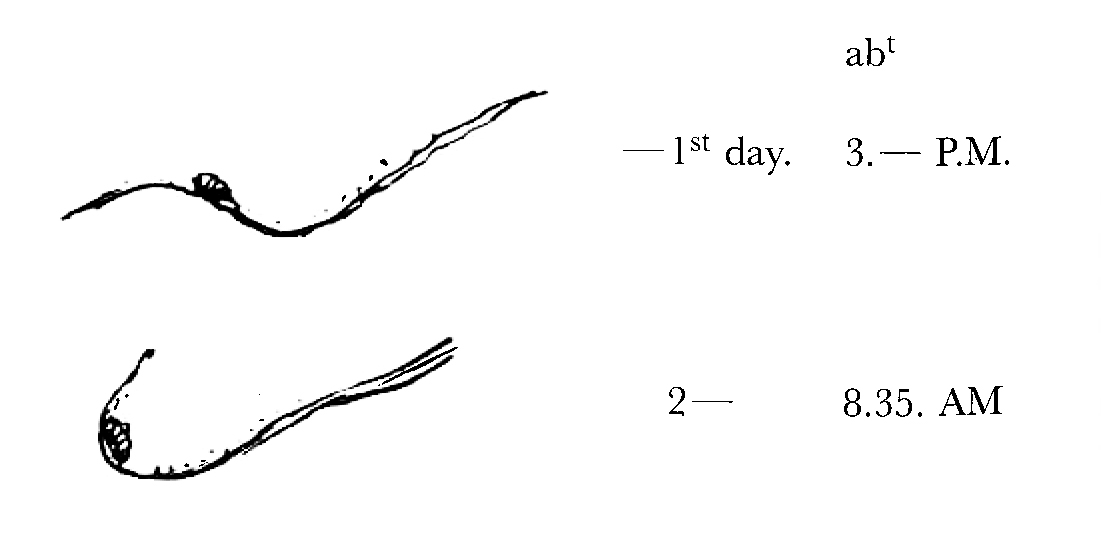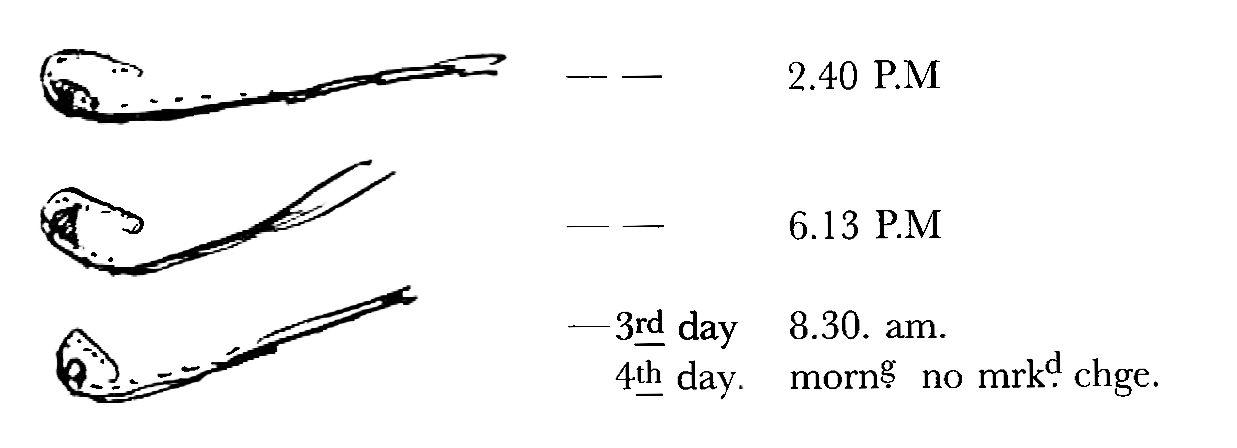From Daniel Oliver 25 September 1860
Kew. W.
25th. IX/60
Dear Sir,
My results so far with pure gum quite support your opinion.1 Yesterdy. morng. 9.25. a drop was put on a leaf of D. spathulata (a leaf of wh. I enclose) at 2.10 P.M. no marked change,—proby. some inflection of inner glands,—but the marginal patent or recurved. 5.55. do. this day (Tuesdy.) 8.56 AM & 5.48 P.M. No material change as yet. The plant looks unhealthy.
Another drop was placed on a leaf of D rotundifolia? 2.13. P.M. (Yestery.)— No marked result this eveng.
I must try the old gum again. I have not burnt it yet. Besides Im not sure if we used it (the new) in equally strong solution. I intend still trying it.
We have another Drosera I dont know the species,—(I understand Australian) with narrow linear leaves Its rate of incurving some days ago over a fly was as follows


I quite look to working up one or two spinous Floras 2 I think of, as one, the Flora (Florula!) of Aden upon wh. Dr. Anderson is just now engaged here.3 It is to appear in a supplt. to the Linn: Journal It is a very spiny Flora. Then Delile, for Egypt.4 perhaps Kelaart, for Gibraltar.5 Munby’s list for Algeria—6 No. West India.—& Some part of Tropical Australia or Mexico would be important. To contrast I would take our own Flora,—that of Arctic circle (easy)—upon wh. Dr. H. has much material for the Linn Trans. (it will not appear tho‘ I doubt till towds. close of next year)7—V. Diemen’s Land. (J.D.H.)8 So. United States (Chapman).9 Before setting seriously to work upon it I should like to complete a little task I have in hand among the Aurantiaceae wh. I am trying (apart from Citrus) to rearrange.—10
The various sorts of spinosity ought to be separately tabulated,—whether true spines,—epidermal (prickles) & leaf appendages,—hardwd. bracts, &c Often it will be difficult to draw the line between spinose & spineless species,—as among Thistles, Dipsacus, &c. &c.
Apropos of Drosera see a footnote in Dr. Bromfield’s ’Flora Vectensis‘ p. 56—“The glands x x x x curving eventually over the flies x x x ensnared by their clammy exudation, but never, so far as I could observe, assisting primarily in their capture by any sudden contraction as in Dionæa muscipula”11
I put a bit of paper in daubed with old gum,— I did not perceive animal odour on burning a piece.
Very faithfully yours | Danl. Oliver. Jr
I doubt if we get good seed this autumn from over 3 or 4 of the isosceles beds!12
CD annotations
Footnotes
Bibliography
Anderson, Thomas. 1860. Florula Adenensis. A systematic account, with descriptions, of the flowering plants hitherto found at Aden. Journal of the Linnean Society (Botany) 5 suppl. 1: i–xxiv, 1–47.
Bromfield, William Arnold. 1856. Flora Vectensis: being a systematic description of the phænogamous or flowering plants and ferns indigenous to the Isle of Wight. Edited by William Jackson Hooker and Thomas Bell Salter. London: William Pamplin.
Chapman, Alvan Wentworth. 1860. Flora of the Southern United States … arranged according to the natural system. The ferns by Daniel C. Eaton. New York.
Hooker, Joseph Dalton. 1855–60. Flora Tasmaniæ. Pt 3 of The botany of the Antarctic voyage of HM Discovery Ships Erebus and Terror, in the years 1839–1843, under the command of Captain Sir James Clark Ross. 2 vols. London.
Kelaart, Edward Frederick. 1846. Flora Calpensis. Contributions to the botany and topography of Gibraltar and its neighbourhood: with plan and views of the rock. London: John Van Voorst.
Munby, Giles. 1859. Catalogus plantarum in Algeria sponte nascentium. Oran.
Raffeneau-Delile, Alire. [1813]. Flore d’Egypt. 2 vols. Paris.
Summary
His results with pure gum on Drosera spathulata entirely support CD’s opinion. Other observations on insectivorous plants.
Letter details
- Letter no.
- DCP-LETT-2927
- From
- Daniel Oliver
- To
- Charles Robert Darwin
- Sent from
- Kew
- Source of text
- DAR 58.1: 1–3
- Physical description
- ALS 6pp †
Please cite as
Darwin Correspondence Project, “Letter no. 2927,” accessed on 19 April 2024, https://www.darwinproject.ac.uk/letter/?docId=letters/DCP-LETT-2927.xml
Also published in The Correspondence of Charles Darwin, vol. 8


